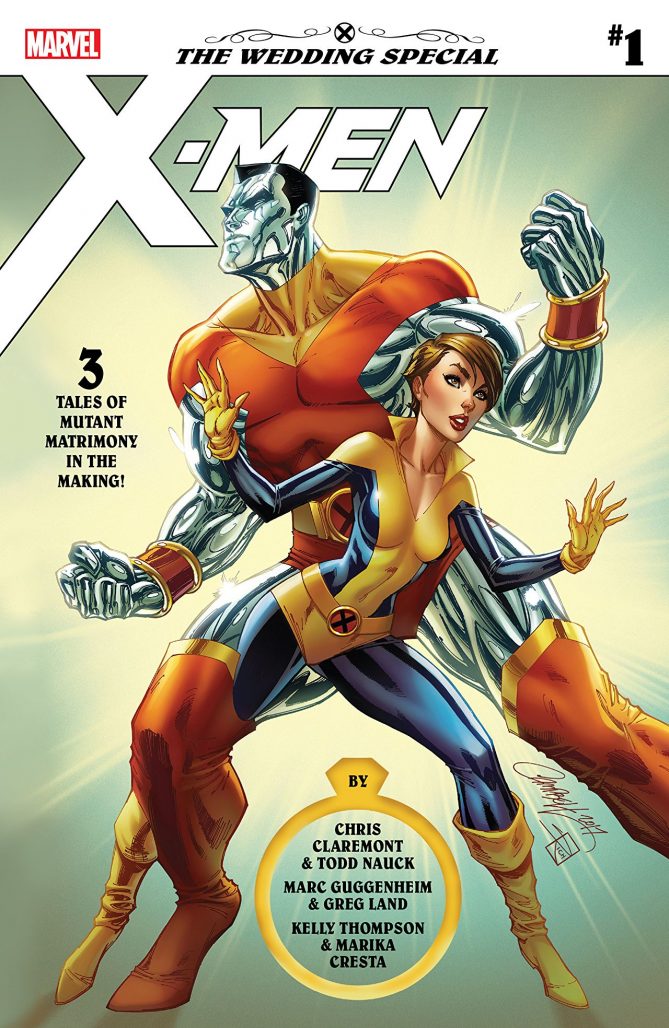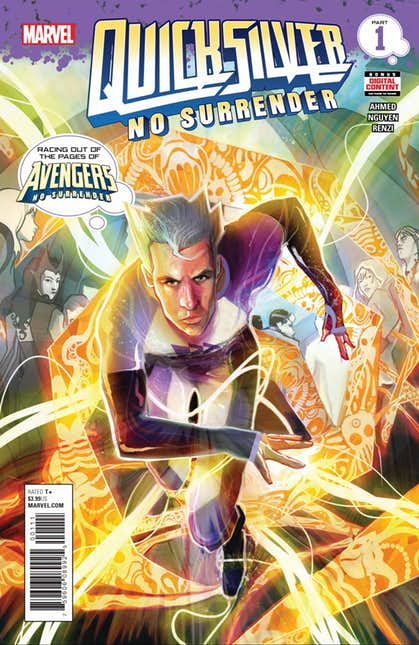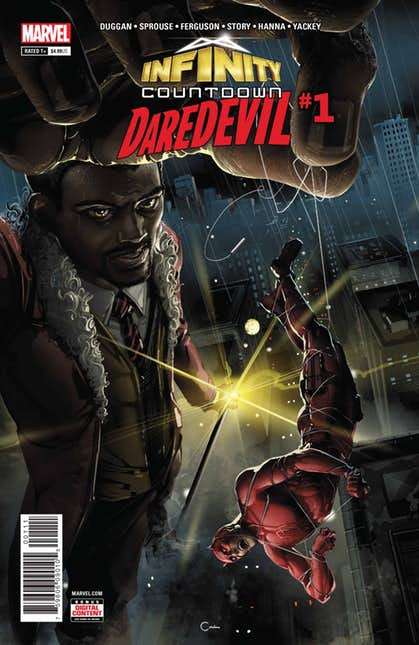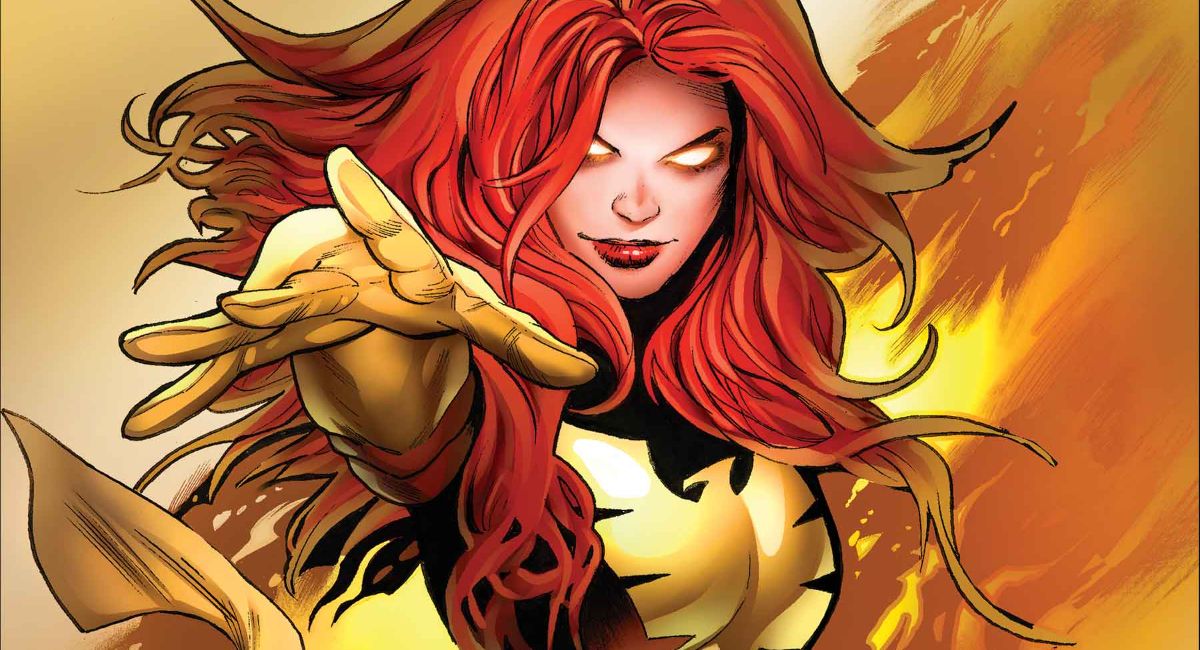When Marc Guggenheim returned to the Peter Rasputin and Kitty Pryde relationship in X-Men Gold #1, I never expected the writer to marry the couple off! Enter: X-Men: The Wedding Special #1. This special issue features the return of beloved X-Men creator, Chris Claremont.
Plus, Marvel’s rising stars Saladin Ahmed and Eric Nguyen are here to craft a brand new Quicksilver title spinning out of Avengers: No Surrender. And how on earth did Daredevil get involved in the middle of Infinity Countdown? Get our thoughts on all these titles this week in The Marvel Rundown!
 X-Men: The Wedding Special #1
X-Men: The Wedding Special #1
Written by Chris Claremont, Marc Guggenheim, and Kelly Thompson
Illustrated by Marika Cresta, Greg Land, and Todd Nauck
Colored by Federico Blee, Jason Keith, and Rachelle Rosenberg
Lettered by Clayton Cowles
Alexander Jones: AJ, Peter Rasputin and Kitty Pryde are getting married. I’m not sure what to make of the pair’s seemingly sudden decision to tie the knot and this issue doesn’t seem to suggest an immense of amount of thought was put into the idea and also plays into some of my worst fears regarding X-Men just playing the hits and working with already established continuity. What did you see in the pages of X-Men: The Wedding Special #1?
AJ Frost: Hey there Alex! As you will surely know, I usually come into the X-Men stories with fresh eyes just because I don’t follow the comics quite as closely. With that being said, this issue’s standalone nature makes it really accessible to longtime fans and newbies alike. Writing as someone who doesn’t follow much of the X-Men stuff anyway, the major draw of this book is the set-up and execution of these vignettes which are pretty easy to get into and follow even when they are part of a bigger narrative.
Jones: My problem with the franchise overall and my main criticism of the issue is nothing new is being established here. Readers already have grown to love Pryde and Rasputin individually but why should we be invested in them as a couple? I wouldn’t say anything in this comic is bad, it is just hard to read the Claremont story and see yet another X-Men tale riding the coattails of better stories instead of establishing something new. This is the danger of telling stories in a shared Universe. The flashback from Claremont involving Pryde, in particular, did a poor job in establishing the state of their relationship.
Frost: Oh for sure. Your criticism is a fair one. There isn’t much set up for anything. The writing in all three of these stories tends to go safe rather than bold, and I think that’s acceptable. This might leave fans disappointed, but on the other hand, the character camaraderie is at a level which was really endearing. I think this counts for much of this issue’s charm, even if it never reaches its full potential. Maybe we’ll get into some of the plot beats in a moment, but there were particular passages which really wrung a lot of emotion out of the simplicity of issue’s premise.
Jones: Given the current state of the X-Men franchise and the aimless nostalgia-soaked past couple of years, this kind of a script just does not cut it for me. I tried to make this point earlier but I’m not sure how well it came across because it really doesn’t seem like X-Men Godfather Chris Claremont even believes the relationship between Colossus and Pryde. I think the big reason why he contributed work to the installment was that he likes Kitty and Nightcrawler and they are pleasant on the issue, but not much else. The recap of her origin and relationships left me in a cold, negative place which further stories were able to slightly mend. The wedding in and of itself I do not believe makes for a good script because readers haven’t been given the proper build-up to this moment to make the issue truly feel like it is paying off a substantial plot thread. Marvel has said themselves they are going in a new direction with the X-Men pretty soon and I hope it involves really changing some things. On a smaller scale, did any of these stories stick out to you?
Frost: If there is a through-line for this issue, it’s that of family. It’s certainly what Claremont really hones in on in his Kitty story. The X-Men have always operated as an ersatz family, with all the squabbles and pettiness attached. But here, all the stories do a solid job of highlighting the interpersonal dynamics of these characters and who have actual families that mean at least something to them. And It’s not enough to say we admire any of them for their powers. Rather, I’ve found the more time I put into these books and look beyond the super-heroic abilities, each X-Men has the unique capability to speak to each of us through personality traits or beliefs. The Kelly Thompson story–the one with the X-Ladies–really displayed the warmness and love each of these characters has for each other, barring previous interactions. And for me personally, the Claremont material concerning Kitty’s relationship with her father felt quite real. Even though one may find the plot thin, or the relationships under-explored, there’s still something which should spark this kind of reaction. I’m sure you reacted much differently than I did here, right?
Jones: If I was invested in this relationship and this was the cherry on top of a solid run of comics this would have gone down a lot better for me. I kind of liked the beginning of the Colossus story and found what he was going through to be kind of endearing at first, but having the demon attack the casino played into a few uncomfortably simple tropes in superhero comics for me. I like Kelly Thompson but her contribution felt overly familiar with me as well and the clingy, obvious characterization from Peter and Kitty across all the writers in the issue wore me down. This isn’t the worst comic ever written and I can almost see how you would like it, but the flaws are too glaring and obvious for me to recommend the title to anyone.
Frost: Chalk it up to my general ignorance of the bigger schemes and dreams of the X-Men universe.
Jones: From an artistic perspective, this issue does not meet my standards of quality. Todd Nauck’s pencils are too imprecise and scratchy for my tastes. The artist has a large Mark Bagley influence but feels even less refined than some of this work. Some panels with lots of characters are lacking detail and there are a couple scenes where the individual faces of certain characters are drawn inconsistently. The issue does a bear a couple good panels with a younger, more innocent-looking Kitty but they are few and far between. Greg Land’s photo-referenced and generic pencils make for another moment in the issue bearing incredibly generic art and there are a few panels from Marika Cresta which are anatomically incorrect in the worst way.
Frost: No arguments here. The art throughout is bland city. Maybe it was a time crunch, but I think the writing in these stories should have deserved some art that was up to par.
Jones: To sum this all up for me, the X-Men franchise desperately needs to stop being a nostalgia act and a find way to move forward while honoring the past. SKIP.
Frost: My reaction is rosier than yours. I’m going with a STRONG BROWSE for this one, only because I felt a connection with the Kitty Pryde stories which I found to have good character beats and surprising emotion in some parts.
Joe Grunenwald: Looks like it’s up to me to break this tie! The thing that struck me the most about this issue was how very little of it was about Piotr and Kitty’s relationship. You would think with a title like “X-Men Wedding Special” that this would be a celebration of the couple and their history together. Instead, we get a sloppily-written Kitty Pryde story from Chris Claremont and average stories about the bachelor and bachelorette parties in which neither the bride nor the groom seems particularly happy to be getting married. I don’t know what this comic was hoping to accomplish aside from getting some extra cash out of X-fans. Guggenheim and Thompson’s stories were fine, with Thompson’s being the standout, but I think ultimately I agree with Alex that this comic offered nothing new for these characters. I would have been okay with that if the tone of the book hadn’t been so overall morose, or if the art had been better. It’s a SKIP from me as well.
Frost: You both shall rue this day!
Final Verdict: AJ says STRONG BROWSE while Alexander and Joe say SKIP!
 Quicksilver: No Surrender #1
Quicksilver: No Surrender #1
Written by Saladin Ahmed
Illustrated by Eric Nguyen
Colored by Rico Renzi
Lettered by VC’s Clayton Cowles
Reviewed by Joe Grunenwald
To say that Quicksilver is a divisive character is an understatement. People either seem to love him, or they can’t stand him. My primary exposures to Pietro Maximoff are the JLA/Avengers crossover, where he spends most of his screentime whining about not being as fast as The Flash, and House of M, where he’s basically the big bad behind Wanda’s reality rewrite. Based on those two stories, I can see how he could be an unpopular guy. That said, as a general fan of speedsters, I went into Quicksilver: No Surrender #1 with an open mind, and was pleasantly surprised by what I found.
Nearly every word in this comic is narration from within Quicksilver’s head, and Ahmed uses that to great effect to establish both character and mood. The solitude of Pietro’s life at high speed comes across really well, even before it becomes essentially the central problem of the comic, and it helps explain a lot about why he is the way he is. The aforementioned problem – becoming trapped at superspeed, moving so fast that everyone around appears frozen – is a unique speedster issue, and while I’ve seen it done before, Ahmed still makes it feel fresh. He balances the stress of the situation with some lighter comedic moments that go a long way towards making Pietro relatable.
From an artistic perspective, the work by Eric Nguyen and Rico Renzi on this issue is unlike anything else Marvel is publishing. Nguyen’s work has a looseness that works well for a character who is constantly in motion. Once the world stops around him, Nguyen scales back the detail on Quicksilver’s surroundings in a way that visually displays the character’s isolation. Renzi’s colors on this issue are superb, with psychedelic shapes and blurs as Quicksilver runs, and limited colors only on Pietro after he becomes trapped at superspeed. Once Quicksilver has something to actually fight, the art team shifts into high gear. There are pages where the characters seem to be running off the page as if they’re moving too fast for the ‘camera’ of the comic to keep up with them. It’s a great effect, and not something I recall having seen before in a speedster comic. Superspeed is hard to convey in still images – after all, speed lines will only carry you so far – and Nguyen and Renzi pull it off extremely well.
Quicksilver: No Surrender #1 is an entertaining first issue about a complicated protagonist. This series spins out of the events of Avengers: No Surrender, but is still perfectly accessible for new readers (like me), and only briefly mentions previous events before getting into its own story. It’s a solid beginning for the series.
Verdict: BUY on the strength of interesting characterization and excellent art.
 Infinity Countdown: Daredevil #1
Infinity Countdown: Daredevil #1
Written by Gerry Duggan
Illustrated by Chris Sprouse, Karl Story, Lee Ferguson, Phil Noto, and Scott Hanna
Colored by Matt Yackey
Lettered by Clayton Cowles
Reviewed by AJ Frost
Right from the start, Infinity Countdown: Daredevil #1 plays it safe. We get another retelling of the character’s origin which precedes a rather ho-hum tale about Daredevil intervening with an old street hustler who mugged him in the past. But this street thug just so happens to possess the Mind Stone, which one would think to be enough to make the wielder a cosmic Capo di tutti capi of the entire New York underworld, yet here he barely registers a two on the evil scale. Sure, some bodies hit the floor, but those can be seen from a million miles away. In the greater scheme of things, doesn’t Daredevil have some bigger battles to wage than some random street tough?
While I’m generally a fan of Gerry Duggan’s work, the potential for this story never goes anywhere. The narrative is really more like a series of clichéd vignettes that we’ve seen Daredevil do hundreds of times. There is nothing new or exciting here nor is there any spark of life. It is a superhero by rote. And that’s a shame because with the zeitgeist now focused on the power of the Infinity Stones, there could have been something interesting to play around with during the course of this issue. But, in the end, it all falls flat.
Same goes for the artwork, which is penciled by Lee M. Ferguson, Chris Sprouse, and Phil Noto. It’s so generic and never rises above the level of serviceable. Again, this is such a wasted opportunity as the properties of an Infinity Stone should lead to some aesthetic dexterity. Instead, everything remains pretty bland throughout.
Perhaps I’m being a little too cynical here in my assessment of this issue. I can’t help but be annoyed that Marvel is foisting this Infinity Stones business on all parts of the line even when the results are middling, at best. Sure, there are some solid action scenes and fisticuffs to boot, but what’s the larger purpose here? Why are we investing any time in seeing Murdock engage with a villain so generic and simplistic in his motives that we already know that path this book is going to take twenty pages before the finale?
In the end, even with the twist ending (which is a twist I believe already occurred this year, or maybe it last year), there wasn’t enough mojo contained in this issue to get me excited. Maybe it’s because it’s only a tie-in to a larger story, but there is nothing here that will be memorable.
Final Verdict: This book is a SKIP. The lack of any clear purpose or narrative thrust makes following the adventures of Matt Murdock a frustrating endeavor to say the least.
Next week Bendis is officially out at Marvel with Iron Man’s big milestone issue!



 X-Men: The Wedding Special #1
X-Men: The Wedding Special #1
 Quicksilver: No Surrender #1
Quicksilver: No Surrender #1
 Infinity Countdown: Daredevil #1
Infinity Countdown: Daredevil #1






Quicksilver sounds and looks awesome! Cool
Comments are closed.